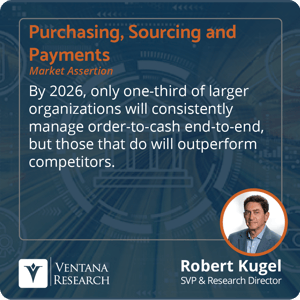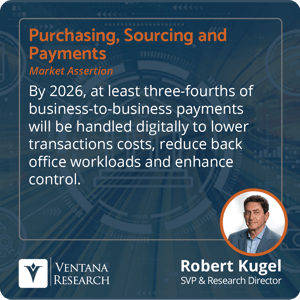Ventana Research expanded its core Office of Finance focus areas this year to reflect new and important opportunities to use technology to gain effectiveness through greater efficiency. The focus area we caption as “Purchasing, Sourcing and Payments” also includes receivables. Doing a better job of record-keeping and organizing paperwork, especially in a minutiae-laden process like order-to-cash, may seem trivial. Yet, when the pandemic required organizations to lock down in early 2020, digitally transforming core business processes became essential, and the need to operate remotely presented a new set of challenges best addressed by software. Ventana Research asserts that by 2026, only one-third of larger organizations will consistently manage order-to-cash end-to-end, but those that do will outperform competitors.
In the United States especially, as the cost and availability of credit becomes a growing concern, organizations are paying closer attention  to working capital. Increasingly, organizations are using accounts receivable (A/R) automation to shorten their collection period and reduce their days sales outstanding (DSOs) by managing order-to-cash as a single end-to-end process rather than as set of discrete steps handled by individual business silos. They are also using workflows to orchestrate the entire process, handling changes, exceptions and escalations, which can significantly cut cycle times. Automation increases accuracy through eliminating errors that can occur in manual processes. By being able to constantly monitor the status of transactions, automation can increase efficiency, productivity and control of the process, thereby improving the customer experience.
to working capital. Increasingly, organizations are using accounts receivable (A/R) automation to shorten their collection period and reduce their days sales outstanding (DSOs) by managing order-to-cash as a single end-to-end process rather than as set of discrete steps handled by individual business silos. They are also using workflows to orchestrate the entire process, handling changes, exceptions and escalations, which can significantly cut cycle times. Automation increases accuracy through eliminating errors that can occur in manual processes. By being able to constantly monitor the status of transactions, automation can increase efficiency, productivity and control of the process, thereby improving the customer experience.
A/R automation has become increasingly important as business-to-business selling has grown more complex. Buyers want a simpler and more streamlined experience similar to what they expect as individual consumers, but they also want greater control of how and where money is spent. Transactions are complicated because sales may be one-offs, or they may be covered by a negotiated annual contract that sets pricing, discounts, terms and conditions. Customers can have complex invoicing requirements such as wanting to be billed at individual business units or locations, while others require a single bill for a division or for the company as a whole. Some outsource the process to a third party. There are a growing number of accounts payable portals that buyers use to streamline their processes but having to interact with those portals, especially in managing a digital relationship, requires automation. Companies that still rely on printing and mailing out bills face escalating costs of using paper-based systems. All of these variables can complicate a transaction and lead to errors and disagreements with the customer that can be avoided when order-to-cash is managed programmatically.
End-to-end A/R automation increases control because all tasks are performed as they should be. When exceptions occur, organizations can craft their preferred method for dealing with them, including approvals and signoffs if necessary. Individuals find it easy to keep track of what they have to do because, almost always, the software gives managers and executives a dashboard that alerts them when tasks are overdue, when they need to intervene in some process and how well the system is working or not. End-to-end automation is possible because all data is captured digitally at the source. Data integrity is maintained from beginning to end because all data movements are managed programmatically, significantly reducing errors caused by data entry mistakes. This cuts the time needed to find and correct errors and eliminates many of the checks and reconciliations that staff accountants might be doing to ensure that bills are accurate. Needing to operate remotely forced organizations to begin the process of digitally transforming finance and accounting, which will continue to change the fundamentals of how departments operate. Moreover, within the disruption of the pandemic, the U.S. Bureau of Labor Statistics found that over 300,000 accountants retired or left the profession, while fewer people are becoming accountants. The shortage has accelerated digital transformation.
Increasingly, payments are handled digitally, and that trend will continue. Ventana Research asserts that by 2026, at least three-fourths  of business-to-business payments will be handled digitally to lower transactions costs, reduce back-office workloads and enhance control. Yet, complexity in collection is growing because increasingly the check isn’t in the mail and the diverse payment sources complicate the job of matching payments and invoices. Collections are further complicated by innovations like payment cards, many of which are single-use, and the related advice may not provide all the data needed to process and apply the payment. Particularly in North America, there will continue to be paper checks and lockboxes.
of business-to-business payments will be handled digitally to lower transactions costs, reduce back-office workloads and enhance control. Yet, complexity in collection is growing because increasingly the check isn’t in the mail and the diverse payment sources complicate the job of matching payments and invoices. Collections are further complicated by innovations like payment cards, many of which are single-use, and the related advice may not provide all the data needed to process and apply the payment. Particularly in North America, there will continue to be paper checks and lockboxes.
In some types of business, deductions may be a standard practice. Having technology assess the deductions applied by the buyer, flagging those that need disputing, can add to the bottom line without requiring a major effort by the staff and enable faster processing and collections.
Managing accounts receivable and accelerating payments by focusing on overdue accounts is still an important way to accelerate cash flow, but technology now makes it possible to address some of the root causes of payment delays, especially in those instances where the issue is not the customer's ability to pay. Generally, these are achieved by eliminating barriers to payment, especially in ensuring that invoices are accurate and handling exceptions, errors and changes is streamlined. Adapting to change is important because variables including orders changing, partial fills, pricing discrepancies and so on shift constantly. Since the process is imperfect, being able to deal with inevitable problems rapidly with complete confidence accelerates the collection of cash and contributes to a positive customer experience.
Making better use of technology to change how companies manage invoice-to-cash is often stymied by organizational barriers. For instance, the end-to-end process may not be viewed as just that. Instead, the people doing the work only see their part of it. They may consider the issues they confront daily as simply something that comes with the territory, not something they can do anything about. It’s also a cross-silo effort, which contributes to the fragmented view from the trenches. Conversely, the people in the company that should have a broader view — the CFO and CEO, for example — may not be aware of the technology and operational roots of the issues confronting the staff. They may not appreciate the payoff potential from A/R automation, or they may have an outdated understanding of what’s possible with technology.
I recommend that finance executives routinely examine their accounts receivable processes to improve their performance. I also recommend that those who do not have end-to-end order to cash processes and systems that support them immediately begin to investigate the most cost-effective way to implement these in their organization.
Regards,
Robert Kugel

 to working capital. Increasingly, organizations are using accounts receivable (A/R) automation to shorten their collection period and reduce their
to working capital. Increasingly, organizations are using accounts receivable (A/R) automation to shorten their collection period and reduce their  of business-to-business payments will be handled digitally to lower transactions costs, reduce back-office workloads and enhance control. Yet, complexity in collection is growing because increasingly the check isn’t in the mail and the diverse payment sources complicate the job of matching payments and invoices. Collections are further complicated by innovations like payment cards, many of which are single-use, and the related advice may not provide all the data needed to process and apply the payment. Particularly in North America, there will continue to be paper checks and lockboxes.
of business-to-business payments will be handled digitally to lower transactions costs, reduce back-office workloads and enhance control. Yet, complexity in collection is growing because increasingly the check isn’t in the mail and the diverse payment sources complicate the job of matching payments and invoices. Collections are further complicated by innovations like payment cards, many of which are single-use, and the related advice may not provide all the data needed to process and apply the payment. Particularly in North America, there will continue to be paper checks and lockboxes.








